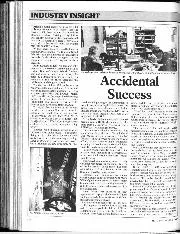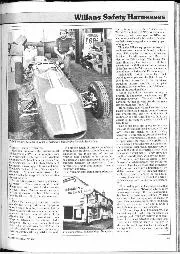

Industry insight: Willans Safety Harnesses
Accidental success Britain's motor racing business has a lot more elements to its success than the Cosworth V8, front running chassis and the Hewland gearbox. Thriving cottage industries can also…
back to the last century. Look closer still and you’ll see that even the wheelbase of the Vanquish is no different to that of a 2003 DB9.
The charge therefore is that the Vanquish is not a new car after all, but another reworking of an existing theme, dressed up and renamed to justify its place in the line up and price in the market.
Actually it’s not as simple as that. There is rather more to this Vanquish, and while only an Aston employee might call it a completely new car, the truth is that the Vanquish represents the biggest redesign in the history of the V/H platform which has underpinned all Aston product since the DB9. In fact, and unlike the only mildly modified and now discontinued Virage, the Vanquish really does earn the right to be thought of as a model distinct from the DB9.
At its heart lies a tub Aston claims is 75 per cent new. The bonded aluminium superstructure the company has been using for nearly 10 years is strong and highly versatile, allowing it to be used for the two-seat Vantage, four-door Rapide and everything in between, but it is also heavy and not space-efficient. But a careful reworking incorporating large amounts of carbon fibre has provided critical extra legroom in the cabin, improved boot space and a 25 per cent increase in torsional rigidity. It has also enabled the engine to be lowered. Carbon fibre is now also the only material used for the bodywork, unlike the DBS that used carbon only for bonnet, boot and front wings.
The engine has also been substantially breathed upon. Back in the days of the DB7 Vantage it produced just 414bhp but with the latest battery of improvements including variable valve timing on both the induction and exhaust side, improved breathing and fully machined combustion chambers, that figure now stands at 565bhp for an unchanged 5.9-litre capacity. It sounds impressive only until you appreciate that the new V12 in the Ferrari F12 displaces less than a third of a litre extra capacity yet generates some 730bhp and deploys it in a car weighing over 100kg less.
But perhaps this is not a fair comparison. First, the Ferrari is over £40,000 more expensive (though that’s unlikely to dissuade many shopping in this region of the market) but also the Vanquish is an unashamed GT car, not an out and out sports car like the Ferrari.
It’s a role to which the Vanquish seems well attuned. If you’re 6ft 4in like me, you’ll appreciate being comfortable for the first time in a V12 Aston. But irritatingly, the steering column has not been given a commensurate increase in reach so it’s now a slightly uncomfortable stretch away. The dash is an odd blend of old and new: there’s a new centre stack with, heaven be praised, an at least reasonable navigation system at last, but as mentioned earlier, those dials are just difficult to read.
So you press the still-annoying glass key into the dash, hear the rejuvenated V12 bark approvingly into life, tug a paddle, release the fly-off handbrake and head out. At first the Vanquish is a little disappointing. It now has a launch control feature which I imagine is the only reason it’s able to post a 4.1sec 0-62mph time. It just doesn’t feel that quick: pleasantly and invigoratingly rapid for sure, but stone-me-I’d-better-lift-now like even the F12’s predecessor the 599GTB? Not at all. It’s not immediately clear why this is. Its power to weight ratio is better than a Nissan GT-R
which feels appallingly fast everywhere. For want of any other culprit, I’m blaming the old six-speed auto gearbox. A double-clutch transmission that would improve performance, response, shift times, economy and emissions is clearly needed. And then you remember this is an Aston Martin, a marque that’s rarely if ever been concerned with being the fastest of them all. In here it’s all about the quality of the experience, not how many tenths you can save from one point to the next. What Aston has created is its most convincing GT since the DB5. Forget the
numbers and savour instead the feel of the steering, the classiness of its damping, the exceptional balance of its chassis. It’s refined at speed, and the near-doubling of its boot capacity is important too.
During my brief period in the car I even managed a few laps on a track, an environment for which it was not designed, and it still felt at home. Far friendlier than any Ferrari, a stranger to understeer and a lover of gentle drifts, its message was that it was on your side, which is just the kind of information you need when the back breaks loose in someone else’s £190,000 supercar.
Unlike a Ferrari F12, the Vanquish is not a car to fall for the moment you see it. Its charms are less obvious and, yes, less potent too. But they are there and they are strong: this car is more changed for the better than it looks, and the price has been cleverly positioned between rival Bentleys and Ferraris in a little niche of its own.
In many ways it feels like a return to Astons of old, which relied not on cutting-edge technology as did the DB9 when it was new, but on a certain, undeniable old English charm. Time alone will tell if, unlike its ancestors, Aston Martin can harness that charm and turn it into sales success.



